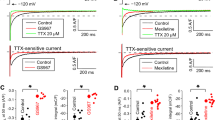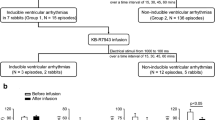Abstract
Although beat-to-beat variability (short-term variability, SV) of action potential duration (APD) is considered as a predictor of imminent cardiac arrhythmias, the underlying mechanisms are still not clear. In the present study, therefore, we aimed to determine the role of the major cardiac ion currents, APD, stimulation frequency, and changes in the intracellular Ca2+ concentration ([Ca2+]i) on the magnitude of SV. Action potentials were recorded from isolated canine ventricular cardiomyocytes using conventional microelectrode techniques. SV was an exponential function of APD, when APD was modified by current injections. Drug effects were characterized as relative SV changes by comparing the drug-induced changes in SV to those in APD according to the exponential function obtained with current pulses. Relative SV was increased by dofetilide, HMR 1556, nisoldipine, and veratridine, while it was reduced by BAY K8644, tetrodotoxin, lidocaine, and isoproterenol. Relative SV was also increased by increasing the stimulation frequency and [Ca2+]i. In summary, relative SV is decreased by ion currents involved in the negative feedback regulation of APD (I Ca, I Ks, and I Kr), while it is increased by I Na and I to. We conclude that drug-induced effects on SV should be evaluated in relation with the concomitant changes in APD. Since relative SV was decreased by ion currents playing critical role in the negative feedback regulation of APD, blockade of these currents, or the beta-adrenergic pathway, may carry also some additional proarrhythmic risk in addition to their well-known antiarrhythmic action.








Similar content being viewed by others
References
Abi-Gerges N, Valentin JP, Pollard CE (2010) Dog left ventricular midmyocardial myocytes for assessment of drug-induced delayed repolarization: short-term variability and proarrhythmic potential. Br J Pharmacol 159:77–92. doi:10.1016/S0008-6363(02)00853-2
Bányász T, Fülöp L, Magyar J, Szentandrássy N, Varró A, Nánási PP (2003) Endocardial versus epicardial differences in L-type calcium current in canine ventricular myocytes studied by action potential voltage clamp. Cardiovasc Res 58:66–75. doi:10.1016/S0008-6363(02)00853-2
Bányász T, Horváth B, Virág L, Bárándi L, Szentandrássy N, Harmati G, Magyar J, Marangoni S, Zaza A, Varró A, Nánási PP (2009) Reverse rate dependency is an intrinsic property of canine cardiac preparations. Cardiovasc Res 84:237–244. doi:10.1093/cvr/cvp213
Bárándi L, Virág L, Jost N, Horváth Z, Koncz I, Papp R, Harmati G, Horváth B, Szentandrássy N, Bányász T, Magyar J, Zaza A, Varró A, Nánási PP (2010) Reverse rate-dependent changes are determined by baseline action potential duration in mammalian and human ventricular preparations. Basic Res Cardiol 105:315–323. doi:10.1007/s00395-009-0082-7
Fülöp L, Szigeti G, Magyar J, Szentandrássy N, Ivanics T, Miklós Z, Ligeti L, Kovács A, Szénási G, Csernoch L, Nánási PP, Bányász T (2003) Differences in electrophysiological and contractile properties of mammalian cardiac tissues in bicarbonate- and HEPES-buffered solutions. Acta Physiol Scand 178:11–18. doi:10.1046/j.1365-201X.2003.01114.x
Heijman J, Zaza A, Johnson DM, Rudy Y, Peeters RLM, Volders PGA, Westra RL (2013) Determinants of beat-to-beat variability of repolarization duration in the canine ventricular myocyte: a computational analysis. PLoS Comput Biol 9:e1003202. doi:10.1371/journal.pcbi.1003202
Hinterseer M, Beckmann BM, Thomsen MB, Pfeufer A, Dalla Pozza R, Loeff M, Netz H, Steinbeck G, Vos MA, Kääb S (2009) Relation of increased short-term variability of QT interval to congenital long-QT syndrome. Am J Cardiol 103:1244–1248. doi:10.1016/j.amjcard.2009.01.011
Hinterseer M, Beckmann BM, Thomsen MB, Pfeufer A, Ulbrich M, Sinner MF, Perz S, Wichmann HE, Lengyel C, Schimpf R, Maier SK, Varró A, Vos MA, Steinbeck G, Kääb S (2010) Usefulness of short-term variability of QT intervals as a predictor for electrical remodeling and proarrhythmia in patients with nonischemic heart failure. Am J Cardiol 106:216–220. doi:10.1016/j.amjcard.2010.02.033
Horváth B, Magyar J, Szentandrássy N, Birinyi P, Nánási PP, Bányász T (2006) Contribution of IKs to ventricular repolarization in canine myocytes. Pflugers Arch 452:698–706. doi:10.1007/s00424-006-0077-2
Horvath B, Banyasz T, Jian Z, Hegyi B, Kistamas K, Nanasi PP, Izu LT, Chen-Izu Y (2013) Dynamics of the late Na+ current during cardiac action potential and its contribution to afterdepolarizations. J Mol Cell Cardiol 64:59–68. doi:10.1016/j.yjmcc.2013.08.010
Jacobson I, Carlsson L, Duker G (2011) Beat-by-beat QT interval variability, but not QT prolongation per se, predicts drug-induced torsades de pointes in the anaesthetised methoxamine-sensitized rabbit. J Pharmacol Toxicol Methods 63:40–46. doi:10.1016/j.vascn.2010.04.010
Johnson DM, Heijman J, Pollard CE, Valentin JP, Crijns HJ, Abi-Gerges N, Volders PG (2010) IKs restricts excessive beat-to-beat variability of repolarization during beta-adrenergic receptor stimulation. J Mol Cell Cardiol 48:122–130. doi:10.1016/j.yjmcc.2009.08.033
Johnson DM, Heijman J, Bode EF, Greensmith DJ, Van der Linde H, Abi-Gerges N, Eisner DA, Trafford AW, Volders PG (2013) Diastolic spontaneous calcium release from the sarcoplasmic reticulum increases beat-to-beat variability of repolarization in canine ventricular myocytes after β-adrenergic stimulation. Circ Res 112:246–256
Lemay M, de Lange E, Kucera JP (2011) Effects of stochastic channel gating and distribution on the cardiac action potential. J Theor Biol 281:84–96. doi:10.1016/j.jtbi.2011.04.019
Lengyel C, Varró A, Tábori K, Papp JG, Baczkó I (2007) Combined pharmacological block of IKr and IKs increases short-term QT interval variability and provokes torsades de pointes. Br J Pharmacol 151:941–951. doi:10.1038/sj.bjp.0707297
Magyar J, Lost N, Körtvély Á, Bányász T, Virág L, Szigligeti P, Varró A, Papp JGY, Nánási PP (2000) Effects of endothelin-1 on calcium and potassium currents in undiseased human ventricular myocytes. Pflugers Arch 441:144–149. doi:10.1007/s004240000400
Michael G, Dempster J, Kane KA, Coker SJ (2007) Potentiation of E-4031-induced torsade de pointes by HMR1556 or ATX-II is not predicted by action potential short-term variability or triangulation. Br J Pharmacol 152:1215–1227. doi:10.1016/S0008-6363(02)00853-2
Pueyo E, Corrias A, Virág L, Jost N, Szél T, Varró A, Szentandrássy N, Nánási PP, Burrage K, Rodríguez B (2011) A multiscale investigation of repolarization variability and its role in cardiac arrhythmogenesis. Biophys J 101:2892–2902. doi:10.1016/j.bpj.2011.09.060
Szabó G, Szentandrássy N, Bíró T, Tóth BI, Czifra G, Magyar J, Bányász T, Varró A, Kovács L, Nánási PP (2005) Asymmetrical distribution of ion channels in canine and human left ventricular wall: epicardium versus midmyocardium. Pflugers Arch 450:307–316. doi:10.1007/s00424-005-1445-z
Szentadrássy N, Bányász T, Bíró T, Szabó G, Tóth BI, Magyar J, Lázár J, Varró A, Kovács L, Nánási PP (2005) Apico-basal inhomogeneity in distribution of ion channels in canine and human ventricular myocardium. Cardiovasc Res 65:851–860. doi:10.1016/j.cardiores.2004.11.022
Tereshchenko LG, Han L, Cheng A, Marine JE, Spragg DD, Sinha S, Dalal D, Calkins H, Tomaselli GF, Berger RD (2010) Beat-to-beat three-dimensional ECG variability predicts ventricular arrhythmia in ICD recipients. Heart Rhythm 7:1606–1613. doi:10.1016/j.hrthm.2010.08.022
Thomsen MB, Verduyn SC, Stengl M, Beekman JD, de Pater G, van Opstal J, Volders PG, Vos MA (2004) Increased short-term variability of repolarization predicts d-sotalol-induced torsades de pointes in dogs. Circulation 110:2453–2459. doi:10.1161/01.CIR.0000145162.64183.C8
Van der Linde H, Van de Water A, Loots W, Van Deuren B, Lu HR, Van Ammel K, Peeters M, Gallacher DJ (2005) A new method to calculate the beat-to-beat instability of QT duration in drug-induced long QT in anesthetized dogs. J Pharmacol Toxicol Methods 52:168–177. doi:10.1016/j.vascn.2005.03.005
Varro A, Balati B, Iost N, Takacs J, Virag L, Lathrop DA, Lengyel CS, Tálosi L, Papp JG (2000) The role of the delayed rectifier component IKs in dog ventricular muscle and Purkinje fibre repolarization. J Physiol 523:67–81. doi:10.1111/j.1469-7793.2000.00067.x
Virág L, Jost N, Papp R, Koncz I, Kristóf A, Kohajda ZS, Harmati G, Carbonell-Pascual B, Ferrero JM Jr, Papp JG, Nánási PP, Varró A (2011) Analysis of the contribution of Ito to repolarization in canine ventricular myocardium. Br J Pharmacol 164:93–105. doi:10.1111/j.1476-5381.2011.01331.x
Volders PG, Stengl M, van Opstal JM, Gerlach U, Spatjens RL, Beekman JD, Sipido KR, Vos MA (2003) Probing the contribution of IKs to canine ventricular repolarization: key role for β-adrenergic receptor stimulation. Circulation 107:2753–2760. doi:10.1161/01.CIR.0000068344.54010.B3
Zaniboni M, Pollard AE, Yang L, Spitzer KW (2000) Beat-to-beat repolarization variability in ventricular myocytes and its suppression by electrical coupling. Am J Physiol Heart Circ Physiol 278:H677–H687. ISSN: 0363–6135
Zaza A, Rocchetti M (2013) The late Na+ current—origin and pathophysiological relevance. Cardiovasc Drugs Ther 27:61–68. doi:10.1007/s10557-012-6430-0
Acknowledgments
Financial support was provided by grants from the Hungarian Scientific Research Fund (OTKA-K100151, OTKA-K109736, OTKA-K101196, OTKA-PD101171, and OTKA-NK104331). Further support was obtained from the Hungarian Government and the European Community (TAMOP-4.2.2.A-11/1/KONV-2012-0045 and TAMOP-4.2.2/B-10/1-2010-0024 research projects). Research of KK and HB was supported by the European Union and the State of Hungary, co-financed by the European Social Fund in the framework of TÁMOP-4.2.4.A/2-11/1-2012-0001 “National Excellence Program.” The authors thank Miss Éva Sági for her excellent technical assistance.
Conflict of interest
The authors declare that they have no conflict of interest.
Author information
Authors and Affiliations
Corresponding author
Rights and permissions
About this article
Cite this article
Szentandrássy, N., Kistamás, K., Hegyi, B. et al. Contribution of ion currents to beat-to-beat variability of action potential duration in canine ventricular myocytes. Pflugers Arch - Eur J Physiol 467, 1431–1443 (2015). https://doi.org/10.1007/s00424-014-1581-4
Received:
Revised:
Accepted:
Published:
Issue Date:
DOI: https://doi.org/10.1007/s00424-014-1581-4




